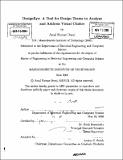| dc.contributor.advisor | Ruth Rosenholtz. | en_US |
| dc.contributor.author | Dorai, Amal Kumar | en_US |
| dc.contributor.other | Massachusetts Institute of Technology. Dept. of Electrical Engineering and Computer Science. | en_US |
| dc.date.accessioned | 2009-06-30T16:59:00Z | |
| dc.date.available | 2009-06-30T16:59:00Z | |
| dc.date.copyright | 2008 | en_US |
| dc.date.issued | 2008 | en_US |
| dc.identifier.uri | http://hdl.handle.net/1721.1/46006 | |
| dc.description | Thesis (M. Eng.)--Massachusetts Institute of Technology, Dept. of Electrical Engineering and Computer Science, 2008. | en_US |
| dc.description | Includes bibliographical references (p. 43-44). | en_US |
| dc.description.abstract | User interface design is critical for the success of any information technology, from software packages to automobile dashboards. Colleagues from many different job functions often need to collaborate to produce these designs, in work environments which can often be strained. Collaborative design software can alleviate some of the problems of these teams, but current software is rarely tailored to the needs of a cross-functional group and does not actively guide users to create better designs. In this thesis, I describe DesignEye, a tool that I have developed with the Perceptual Science Group at MIT. Our tool computes the clutter of images and identifies the most salient visual elements, and allows designers to work with the softare in a tight iterative feedback loop to ensure that the most important design elements garner the most end-user attention. DesignEye is tailored to the use cases we have observed in our studies of design teams, and facilitates side-by-side comparisons of multiple design candidates as interface designers test various ideas. I conclude by demonstrating the extensibility of DesignEye, and its role not only as a tool but as a generalized platform to assist interface designers. Any vision model which quantifies some aspect of human cognitive response to a stimulus can be incorporated into DesignEye, allowing interface designers to create better and more effective user interfaces in an information technology world that is growing rapidly more complex. | en_US |
| dc.description.statementofresponsibility | by Amal Kumar Dorai. | en_US |
| dc.format.extent | 44 p. | en_US |
| dc.language.iso | eng | en_US |
| dc.publisher | Massachusetts Institute of Technology | en_US |
| dc.rights | M.I.T. theses are protected by
copyright. They may be viewed from this source for any purpose, but
reproduction or distribution in any format is prohibited without written
permission. See provided URL for inquiries about permission. | en_US |
| dc.rights.uri | http://dspace.mit.edu/handle/1721.1/7582 | en_US |
| dc.subject | Electrical Engineering and Computer Science. | en_US |
| dc.title | DesignEye : a tool for design teams to analyze and address visual clutter | en_US |
| dc.title.alternative | Design Eye : a tool for design teams to analyze and address visual clutter | en_US |
| dc.type | Thesis | en_US |
| dc.description.degree | M.Eng. | en_US |
| dc.contributor.department | Massachusetts Institute of Technology. Department of Electrical Engineering and Computer Science | |
| dc.identifier.oclc | 355489580 | en_US |

